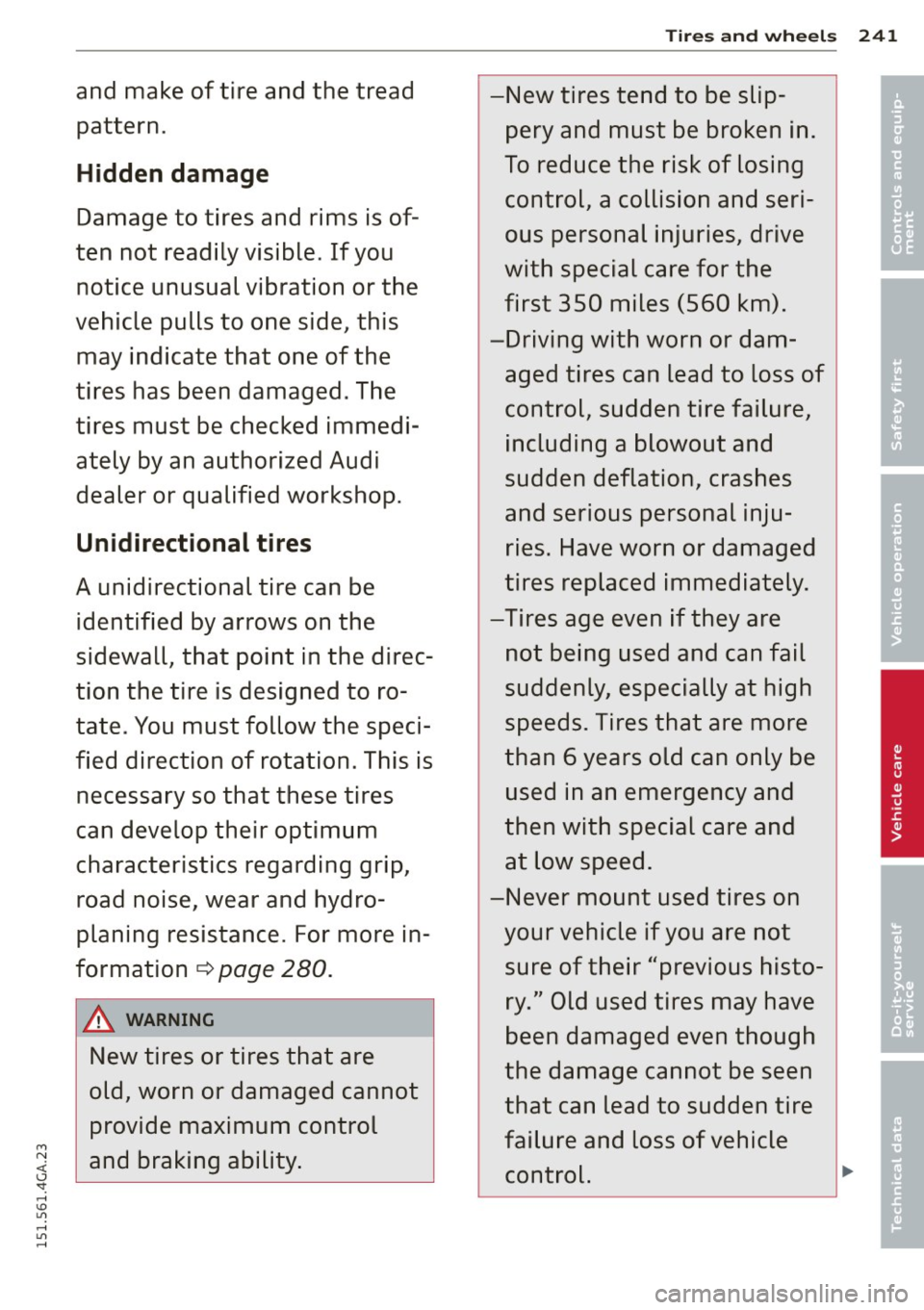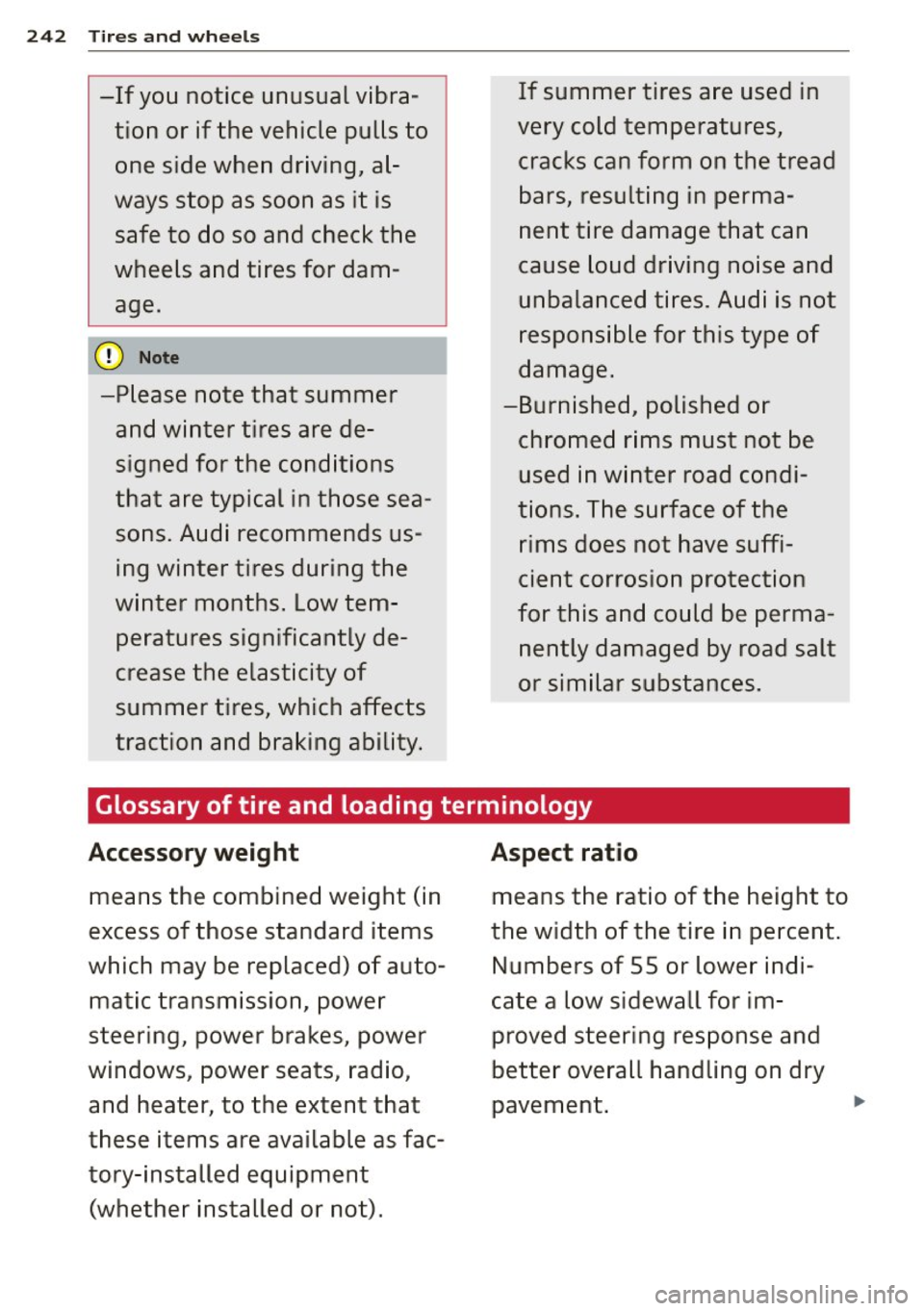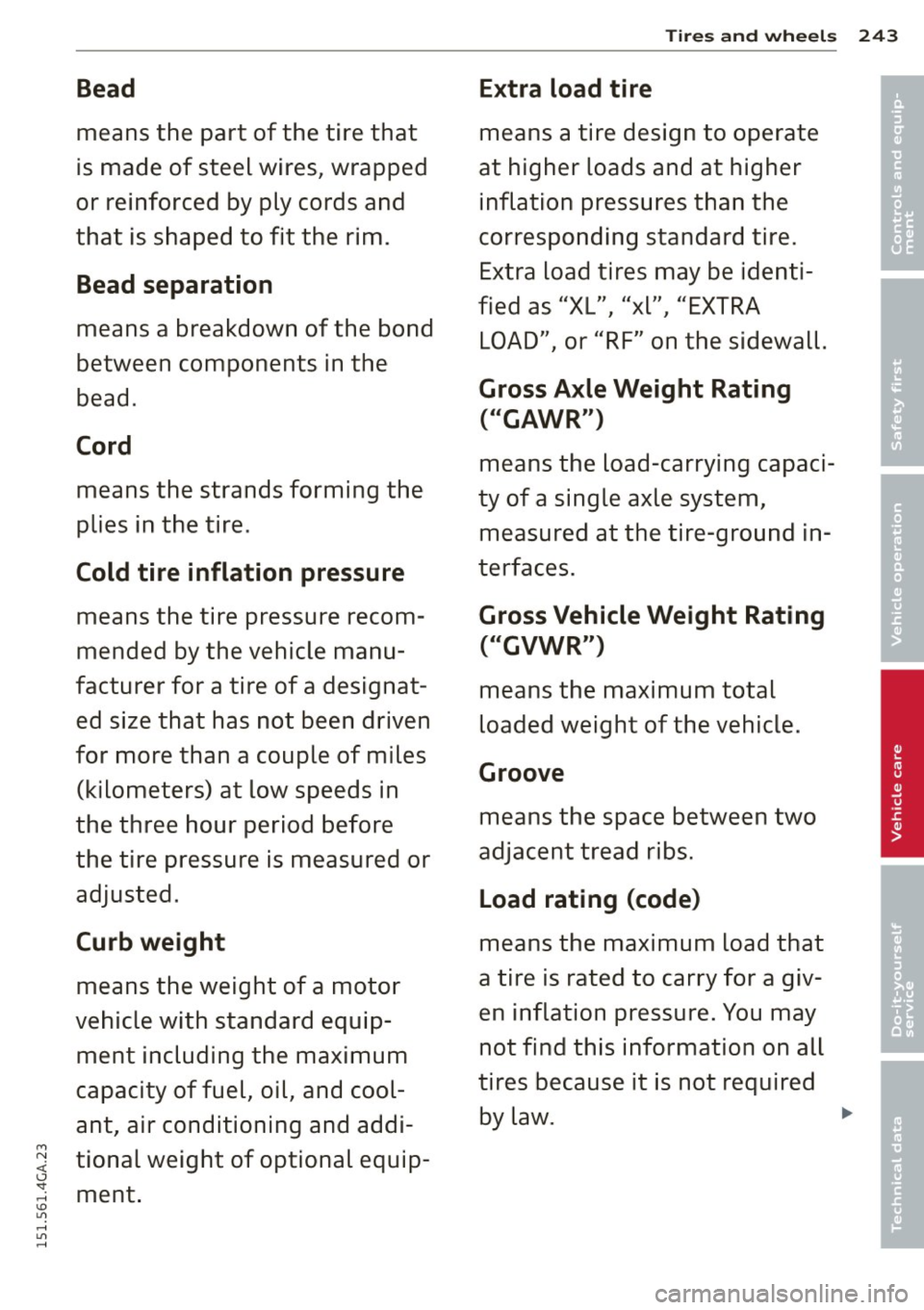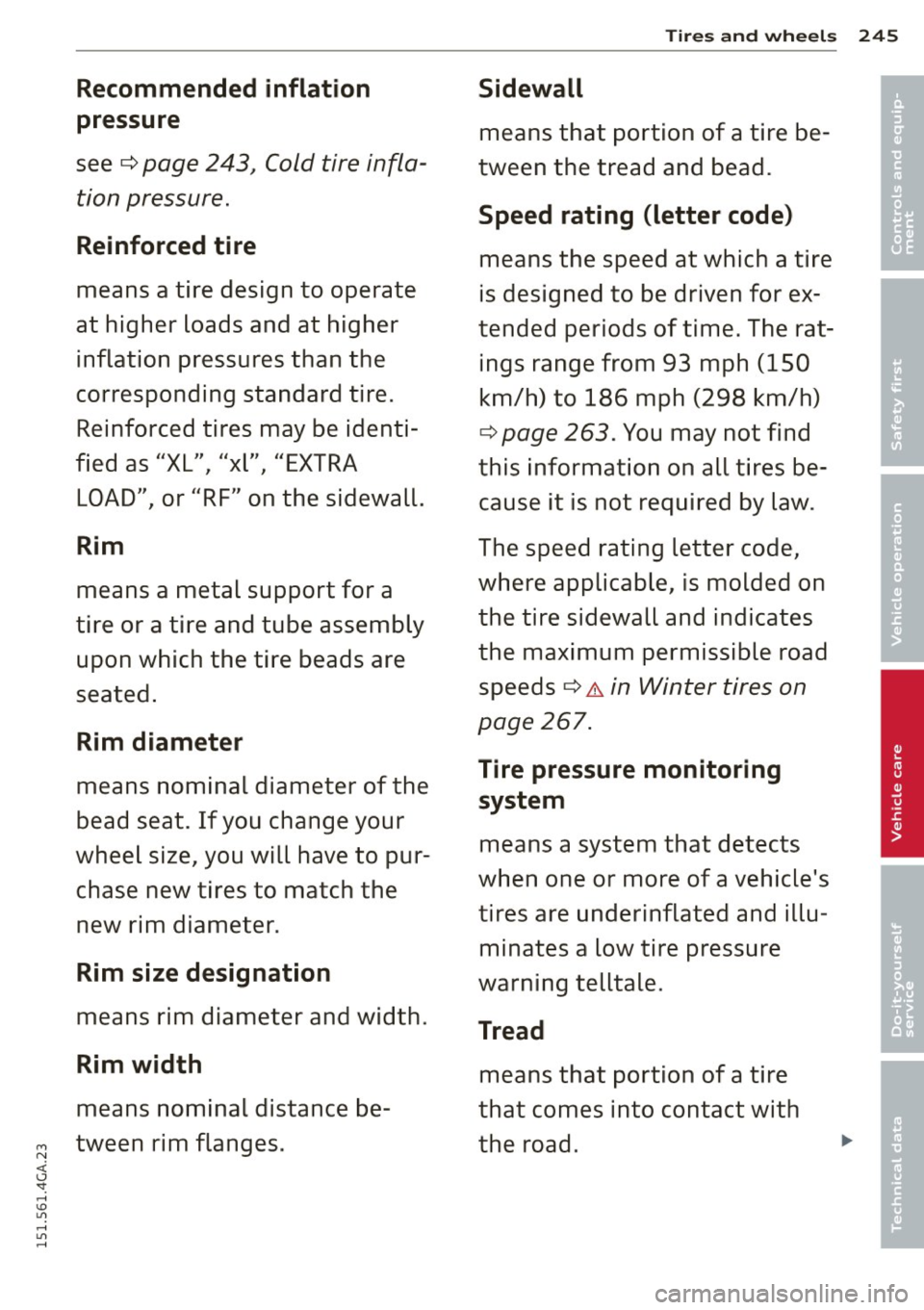2015 AUDI A7 ESP
[x] Cancel search: ESPPage 240 of 316

238 Check ing and filling
cracked an d weake ned when the battery
froze.
- Charge the battery in a we ll ventilated
area. Keep away from open flame or elec
trical spark. Do not smoke. Hydrogen gas
generated by the battery is explosive.
- To reduce the danger of explosion, never
connect or disconnect charger cables
wh ile the charger is operating.
- Fast charg ing a battery is dangerous and
should only be attempted by a compe
tent technician w ith the proper equip
ment.
- Battery acid that may spill during charg
ing should be washed off w ith a solution
of warm water and baki ng soda to neu
t rali ze the acid.
~ Note
Never use a fast charger as a booster to
start the engine. This will seriously dam
age sensitive el ect ronic components, such
as co ntrol units, relays, rad io, etc., as we ll
as th e batte ry charge r.
Battery replacement
The new battery must have the same specifi
cations and dimensions as the original equip
ment battery.
I ntell igent energy management in your vehi
cle is respo nsible for d ist ributing the electr i
cal energy throughou t you r vehi cle
~ page 201. The inte lligen t energy manage
ment system w ill keep the engine battery
charged better than vehicles without t his sys
tem . To make sure the additional electrical en
ergy is available once again after you have
changed the battery, we recommend that you
install batteries of the same type and manu
facture only (the same as those installed at
the t ime your vehicle was delivered). Specifi
cations a re listed on the battery hous ing. You r
author ized de aler m ust code the battery in
the energy management system to enable yo u
to use the energy managemen t fu nctions co r
rectly after replacing the battery. T
he new battery must have the same capacity,
vo ltage ( 12-volts), amperage, construction
and plug sealing.
When ins tall ing t he battery, make su re the ig
nition and a ll elect rical consume rs are switch
ed off.
(D Note
Make sure the ven tilat ion hose on the side
of the ba ttery is connecte d, otherwise
fumes or batte ry acid can lea k out .
- Ve hicles with the Start-S top-System * are
equip ped with a spec ial cycle-proof AGM
battery . Install ing a d iffe rent type of
battery can cause problems in the vehi
cle e lectr ica l system. Whe n replac ing the
vehicle battery, always install one w ith
t he same specifications as the o rigi na l
battery.
@) For the sake of the environment
Because of the prob lem of proper disposal
of a battery, we recomme nd your author
i zed Audi dealer change the battery fo r
you. Batteri es contain sulfur ic acid and
l ead and must a lways be di spo sed o f prop
erly in comp liance wi th all envi ronmental
regulations. Disposing of vehi cle batter ies
imprope rly is very dange rous to the envi
r onment.
Windshield/headlight*
washer container
F ig . 1 99 Engine compartment: cover on the windshield
a n d headl ight * was her fl ui d reservo ir
ll>
Page 243 of 316

Tires and wheels 241
and make of tire and the tread -New tires tend to be slip-•
pattern.
pery and must be broken in. • '
Hidden damage To reduce the risk of losing
Damage to tires and rims is of -control, a collision and seri-
ous personal injuries, drive
ten not readily visible. If you with special care for the
notice unusual vibration or the first 350 miles (560 km).
vehicle pulls to one side, this
-Driving with worn or dam-
may indicate that one of the
aged tires can lead to loss of
tires has been damaged . The
control, sudden tire failure,
tires must be checked immedi-
ately by an authorized Audi including a blowout and
sudden deflation, crashes
dealer or qualified workshop.
and serious personal inju-
Unidirectional tires ries. Have worn or damaged
A unidirectional tire can be tires replaced immediately.
identified by arrows on the -Tires age even if they are
sidewall, that point in the di rec- not being used and can fail
tion the tire is designed to ro- suddenly, especially at high
tate. You must follow the speci- speeds. Tires that are more
fied direction of rotation. This is than 6 years old can only be
necessary so that these tires used in an emergency and
can develop their optimum then with special care and
characteristics regarding grip, at low speed.
road noise, wear and hydro- -Never mount used tires on
planing resistance. For more in- your vehicle if you are not
formation
¢ page 280. sure of their "previous histo-
ry." Old used tires may have
A WARNING
been damaged even though -
New tires or tires that are the damage cannot be seen
old, worn or damaged cannot that can lead to sudden tire
provide maximum control failure and loss of vehicle
M N and braking ability. <(
control. (.J
'SI: ,...., \!) 1.1'1 ,...., 1.1'1 ,....,
Page 244 of 316

242 Tires and wheels
-If you notice unusual vibra
tion or if the vehicle pulls to
one side when driving, al
ways stop as soon as it is
safe to do so and check the
wheels and tires for dam
age.
0 Note
-Please note that summer and winter tires are de
signed for the conditions
that are typical in those sea
sons. Audi recommends us
ing winter tires during the
winter months. Low tem peratures significantly de
crease the elasticity of
summer tires, which affects
traction and braking ability. If summer tires are used
in
very cold temperatures, cracks can form on the tread
bars, resulting in perma
nent tire damage that can
cause loud driving noise and
unbalanced tires. Audi is not
responsible for this type of
damage.
-Burnished, polished or chromed rims must not be used in winter road condi
tions. The surface of the
rims does not have suffi
cient corrosion protection
for this and could be perma
nently damaged by road salt
or similar substances.
Glossary of tire and loading terminology
Accessory weight
means the combined weight (in
excess of those standard items
which may be replaced) of auto matic transmission, power
steering, power brakes, power
windows, power seats, radio, and heater, to the extent that
these items are available as fac
tory-installed equipment (whether installed or not).
Aspect ratio
means the ratio of the height to
the width of the tire in percent.
Numbers of 55 or lower indi
cate a low sidewall for im
proved steering response and
better overall handling on dry
pavement.
...
Page 245 of 316

M N <( (.J
'SI: ,...., \!) 1.1'1 ,...., 1.1'1 ,....,
Bead
means the part of the tire that
is made of steel wires, wrapped
or reinforced by ply cords and
that is shaped to fit the rim .
Bead separation
means a breakdown of the bond
between components in the
bead.
Cord
means the strands forming the
plies in the tire.
Cold tire inflation pressure
means the tire pressure recom
mended by the vehicle manu
facturer for a tire of a designat
ed size that has not been driven
for more than a couple of miles (kilometers) at low speeds in
the three hour period before
the tire pressure is measured or
adjusted.
Curb weight
means the weight of a motor
vehicle with standard equip
ment including the maximum
capacity of fuel, oil, and cool
ant, air conditioning and addi
tional weight of optional equip
ment.
Tires and wheels 243
Extra load tire
means a tire design to operate
at higher loads and at higher inflation pressures than the
corresponding standard tire .
Extra load tires may be identi
fied as "XL", "xl", "EXTRA
LOAD", or "RF" on the sidewall.
Gross Axle Weight Rating ("GAWR")
means the load-carrying capaci
ty of a single axle system,
measured at the tire-ground in
terfaces.
Gross Vehicle Weight Rating ("GVWR")
means the maximum total
loaded weight of the vehicle .
Groove
means the space between two
adjacent tread ribs.
Load rating (code)
means the maximum load that
a tire is rated to carry for a giv
en inflation pressure. You may
not find this information on all
tires because it is not required by law.
•
•
'
Page 247 of 316

Recommended inflation
pressure
see¢ page 243J Cold tire infla
tion pressure.
Reinforced tire
means a tire design to operate
at higher loads and at higher
inflation pressures than the
corresponding standard tire. Reinforced tires may be identi
fied as "XL", "xl", "EXTRA
LOAD", or "RF" on the sidewall.
Rim
means a metal support for a
tire or a tire and tube assembly
upon which the tire beads are
seated.
Rim diameter
means nominal diameter of the
bead seat. If you change your
wheel size, you will have to pur chase new tires to match the
new rim diameter.
Rim size designation
means rim diameter and width.
Rim width
means nominal distance be
~ tween rim flanges.
<( (.J
'SI: ,...., \!) 1.1'1 ,...., 1.1'1 ,....,
Tires and wheels 245
Sidewall
means that portion of a tire be
tween the tread and bead.
Speed rating (letter code)
means the speed at which a tire
is designed to be driven for ex
tended periods of time. The rat ings range from 93 mph (150
km/h) to 186 mph (298 km/h)
¢ page 263. You may not find
this information on all tires be cause it is not required by law.
The speed rating letter code,
where applicable, is molded on
the tire sidewall and indicates
the maximum permissible road speeds ¢
A in Winter tires on
page
267.
Tire pressure monitoring system
means a system that detects
when one or more of a vehicle's tires are underinflated and illu
minates a low tire pressure
warning telltale.
Tread
means that portion of a tire
that comes into contact with
the road.
•
•
'
Page 250 of 316

248 Tires and whee ls
Tire pressure generally refers to tant things you can do to help
the amount of a ir in a tire that avoid sudden tire failure. Un-
it needs it to do its job and derinflated tires are a major
safely carry the combined load cause of sudden tire failure .
of the entire vehicle and its con-
Keeping tires at the right pres-
tents . Tire pressure is measured sure is also important for safe
in kilopascals (kPa), the inter- and responsive vehic le han-
national measuring unit and in dling, traction, braking and
pounds pe r square inch (PSI). load carrying.
Tire pressu res
Ti re pressure is based in part on are particularly important
the vehicle's design and load when the vehicle is being driv-
limit -the greatest amount of en at h igher speeds, and then
weight that the vehicle can car-especially when hea vily loaded
ry safely and the tire size. The even within the permissible
proper tire pressure is frequent-load-carrying capacities ap-
ly referred to as the "recom-proved for your vehicle.
mended cold tire inflation pres-
The recommended tire pres-
sure." Air in the tires expands sures for your Audi depend on
when the tire heats up because the kind of tires on your vehicle
of internal friction when it flex- and the number of passengers
es in use. The ti re pressure is
and/or amount of luggage you
h igher when the tire has
will be transporting.
warmed up than when it is
The tire pressure labe l is locat-
"cold." It is the inflation p res-
ed on the driver's side 8-pillar.
sure in a "cold" tire that counts .
Therefore, you should never let The tire pressure label lists the
recommended cold tire infla-
air out of a warm tire to match
"cold tire inflation pressure" tion pressures for the vehicle at
its maximum capacity weight
recommendations . The tires
would then be underinflated and tires that were on your ve-
and cou ld fai l suddenly . hicle at the time it was manu-
f actured.
...
Maintaining proper tire pres-
sure is one of the most impor-
Page 251 of 316

M N <( (.J
'SI: ,...., \!) 1.1'1 ,...., 1.1'1 ,....,
If you wish to improve comfort
when operating the vehicle at normal load (up to 2/3* occu
pants), you can adjust tire
pressures to those specified
for normal vehicle load. Before
operating the vehicle at maxi mum load, you must increase
the tire pressures to those
specified for maximum vehicle load
c> .&. .
Bear in mind that the tire pres
sure monitoring system can on
ly monitor the tire pressures
you have stored. The system does not recognize the load
condition of your vehicle.
The effectiveness of the tire pressure monitoring system
will be impaired if you store normal load pressures but then
operate the vehicle at its maxi
mum load
c> .&. .
Tires and wheels 249
See the illustration c> fig. 200
for the location of the label on
driver's side B-pillar (color of
the actual label and exact loca
tion on the vehicle will vary slightly).
Note that the following table is
accurate at the time of going to
press and is subject to change.
In the event of discrepancies,
the tire pressure label is locat ed on the driver's side B-pillar
always takes precedence.
The table below lists the rec ommended cold tire inflation pressures for the Audi model
covered by your Owner's Litera
ture at the vehicle's capacity
weight and the tire sizes instal
led on the respective models as
original equipment , or as a fac-
tory option. ..,.
•
•
'
Page 252 of 316

250 Tires and wheels
Model/ Tire designation Tire pressure
Engine normal load condition
full load condition
fronta> reara>
front rear
PSI kPA PSI kPA PSI kPA PSI kPA
A7: 235/55 Rl 7 99Y
32 220 29 200 35 240
38 260 3.0 liter High Performance
6-cylinder
255/45 R18 99H
All Season
32 220 29 200 35 240 38 260
255/45 Rl8 99Y 32 220 29 200
35 240
38 260
High Performance
255/40 R19 lOOH XL
35 240 32 220 38 260 280 All Season 41
255/40 Rl9 lOOY
XL
36 250 32 220 38 260 41 280 High Performance
265/35 R20 99H XL
35 240
32 220 38 260 41
280 All Season
265/35 R20 99Y XL
36 250 32 220 38 260 41
280 High Performance
57: 255/40 R19 lOOY XL
39 270
33 230
42 290 42 290 4.0 liter High Performance
a-cylinder 265/35 R20 99Y XL
High Performance
41 280 35 240 44 300 44 300
XL= reinforced or extra load tire. It may also appear as xl, EXTRA LOAD, or RF on the tire side-
wall.
a) normal load
condition¢ page 247.
The correct tire pressure for the
spare wheel is located on a la
bel on the driver's side B-pillar.
Because technical changes may
be made to vehicle equipment
during the model year, always
compare the tire size designa
tion on the tire pressure label
on your vehicle with the tires on
your vehicle. Make sure that the
tire size information on the ve
hicle label is the same as the
size of the tires on the vehicle. This is especially important if
the vehicle belongs to someone
else or you bought the vehicle
with different rims/tires or you bought the vehicle as a previ
ously owned vehicle.
Remember, your safety and
that of your passengers also de
pends on making sure that load
limits are not exceeded. Vehicle
load includes everybody and ev
erything in and on the vehicle.
These load limits are